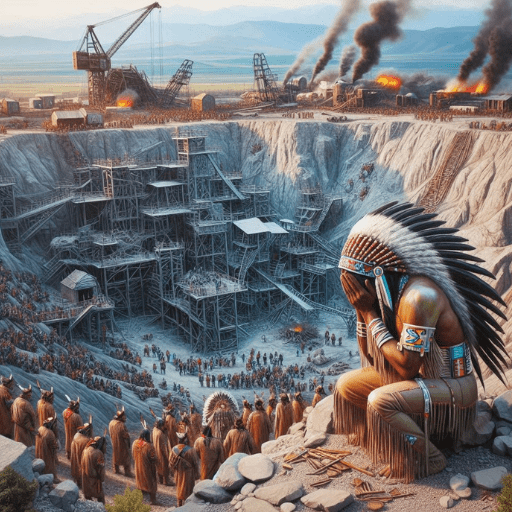Key Takeaways
- The Mexican-American War (1846-1848) significantly expanded U.S. territory. The U.S. gained vast lands including California, New Mexico, and parts of Arizona, Nevada, Utah, and Colorado. This fueled westward expansion and solidified the U.S. as a continental power.
- The war was a direct result of Manifest Destiny and the annexation of Texas. U.S. President Polk’s belief in Manifest Destiny and the desire to expand westward led to the annexation of Texas, which Mexico still considered its territory. This ultimately triggered the war.
- The discovery of gold in California shortly after the war had a profound impact. The California Gold Rush brought a massive influx of people and wealth to the region, accelerating its development and contributing to the economic growth of the U.S.
- The war had devastating consequences for Native American tribes. The influx of settlers during the Gold Rush led to the loss of land, destruction of traditional food sources, disease, and violence against Native Americans, decimating their population and culture.
- The legacy of the war continues to shape U.S.-Mexico relations today. The war and the resulting loss of territory for Mexico created lasting tensions between the two countries.
A Conflict That Paved the Way for the Gold Rush and Territorial Expansion

In the mid-1800s, a conflict erupted that would forever change the face of North America. The Mexican-American War (1846-1848) not only redrew the map of the United States but also set the stage for one of history’s greatest gold rushes. This war, driven by America’s belief in Manifest Destiny, ended with the United States gaining vast territories – including California, where gold would soon be discovered.
The Seeds of War
The story begins with Texas. Once a part of Mexico, Texas declared its independence in 1836 after American settlers in the region revolted against Mexican rule. For nine years, Texas existed as an independent republic, but many Texans dreamed of joining the United States. When the U.S. annexed Texas in 1845, Mexico severed diplomatic relations. The situation grew tenser as both nations disagreed about where Texas ended and Mexico began.
President James K. Polk, a firm believer in Manifest Destiny – the idea that the United States should expand across North America – saw an opportunity. He sent diplomats to Mexico with an offer to buy California and settle the Texas border dispute. When Mexico refused to negotiate, Polk ordered American troops under General Zachary Taylor to advance to the Rio Grande, a river that Mexico didn’t recognize as the border. This move proved to be the spark that lit the powder keg.
A War of Two Nations
The first shots rang out in April 1846, when Mexican cavalry attacked a U.S. patrol, killing 11 American soldiers. President Polk declared that Mexico had “shed American blood upon American soil,” and Congress declared war. What followed was a series of decisive American victories that demonstrated the growing military might of the United States.
The Battle of Palo Alto marked the first major clash, where American artillery proved superior to Mexican cavalry charges. General Zachary Taylor earned the nickname “Old Rough and Ready” as he led American forces to victory at the Battle of Monterrey, where U.S. troops fought house-to-house through the city streets.
Perhaps the most dramatic campaign came under General Winfield Scott, who launched an ambitious amphibious invasion at Veracruz. Scott’s forces captured this crucial port city and then marched inland, following the route of Spanish conquistador Hernán Cortés from three centuries earlier. Despite being outnumbered, Scott’s army won battle after battle, eventually capturing Mexico City itself.
Throughout the war, Mexican General Antonio López de Santa Anna – famous for his victory at the Alamo a decade earlier – tried desperately to stop the American advance. However, superior U.S. artillery and tactical advantages proved too much for Mexican forces to overcome.
The Treaty That Changed America

On February 2, 1848, the Treaty of Guadalupe Hidalgo officially ended the war. The terms dramatically reshaped North America: Mexico ceded nearly half its territory to the United States. This Mexican Cession included California, New Mexico, and parts of what would become Arizona, Nevada, Utah, and Colorado. In return, the U.S. paid Mexico $15 million and assumed $3.25 million in claims against Mexico by U.S. citizens.
The treaty increased U.S. territory by nearly a third, but few could have predicted what would happen just nine days later.
Gold Changes Everything
On January 24, 1848, James W. Marshall discovered gold flakes in the American River while building a sawmill for John Sutter near present-day Sacramento. Though Sutter tried to keep the discovery secret, word spread quickly. By 1849, the California Gold Rush was in full swing.
The timing couldn’t have been more significant. Had the war ended differently, the gold fields would have remained under Mexican control. Instead, the United States now owned what would become one of the richest gold-producing regions in history. The Gold Rush brought approximately 300,000 people to California from all over the world, transforming a sparsely populated territory into a booming American state.
The Hidden Cost: Native American Tribes

While many Americans celebrated their nation’s expansion, Native American tribes faced devastating consequences. The tribes of California – including the Miwok, Yokut, and Maidu – had managed to maintain their traditional ways of life under Mexican rule. However, the flood of American settlers during the Gold Rush proved catastrophic for these communities.
Miners and settlers seized Native American lands, destroyed traditional food sources, and often engaged in violent conflicts with tribal members. Disease and starvation followed. The California state government even passed laws that made it legal to force Native Americans into indentured servitude. Within a generation, many tribes lost not only their lands but also significant portions of their population and cultural heritage.
Building a Continental Nation
The combination of territorial acquisition and the Gold Rush accelerated America’s westward expansion dramatically. New towns sprang up overnight as gold seekers poured into California. The need to transport people and supplies led to improved roads, ports, and eventually railroads. San Francisco transformed from a tiny settlement into a major city within just a few years.
The Gold Rush brought unprecedented wealth into American hands. Between 1848 and 1855, miners extracted more than $750 million worth of gold from California’s rivers and mines. This newfound wealth helped fund America’s continuing expansion and development, powering the nation’s rise as an economic powerhouse.
The Mexican-American War: A Legacy That Echoes Today
The Mexican-American War and its aftermath fundamentally altered both nations. For the United States, it fulfilled the vision of Manifest Destiny, stretching American territory from the Atlantic to the Pacific. The war launched several political careers – including that of Zachary Taylor, who rode his military fame to the presidency in 1848.
For Mexico, the war’s outcome created long-lasting tensions with its northern neighbor. The loss of nearly half its territory remained a painful memory, influencing Mexican-American relations well into the future. The war also established patterns of interaction between the two nations that would persist for generations.
Today, the legacy of the Mexican-American War continues to shape our world. The current U.S.-Mexico border largely follows the lines drawn by the Treaty of Guadalupe Hidalgo. Cities that boomed during the Gold Rush, like San Francisco and Sacramento, remain major urban centers. Perhaps most importantly, the war marked a crucial step in the United States’ emergence as a continental power, setting the stage for its rise to global prominence in the centuries that followed.
The Mexican-American War serves as a reminder of how seemingly separate historical events – a border dispute, a military conflict, and a lucky discovery of gold – can combine to change the course of nations. In just two years, the war reshaped North America, triggered one of history’s greatest gold rushes, and set in motion changes that would transform a expanding nation into a world power.
Frequently Asked Questions (FAQs)
What were the main causes of the Mexican-American War?
The annexation of Texas by the U.S. in 1845, which Mexico disputed. The concept of Manifest Destiny, which fueled American desire for westward expansion. Border disputes between the U.S. and Mexico over the Texas territory.
What were the major outcomes of the war?
Mexico ceded almost half of its territory to the U.S. in the Treaty of Guadalupe Hidalgo. The U.S. paid Mexico $15 million and assumed $3.25 million in claims against Mexico. The California Gold Rush began shortly after the war, leading to a massive influx of people and wealth to the region.
How did the war impact Native Americans?
The war and the subsequent Gold Rush had a devastating impact on Native American tribes in California. They lost their lands, were forced into servitude, and suffered from disease and violence. Their traditional way of life was disrupted, and their population and cultural heritage were severely diminished.
What is the lasting legacy of the Mexican-American War?
The war solidified the U.S. as a continental power and fueled its rise to global prominence. It shaped the current U.S.-Mexico border and continues to influence relations between the two countries. It led to the development of major cities in the American West, such as San Francisco and Sacramento.







